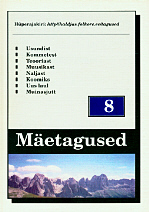Varafolkloorsetelt vokaalzhanridelt lauluni
Historical Strata of the Estonian Folk Music
Author(s): Ingrid RüütelSubject(s): Music
Published by: Eesti Kirjandusmuuseum
Summary/Abstract: The Estonian folk song is usually divided into two main historical-stylistical strata: the runo songs (songs in runo verse form, also called Kalevala-metre songs, alliterative songs etc.) and the newer songs with an end-rhyme and strophic form. Both are characterised by a special musical style. The first one belongs to the old Balto-Finnic culture and derives probably from the last millennium B.C., the latter one is related to the European traditional songlore of the last centuries. Besides runo songs (which are represented in the Estonian tradition first of all by lyrical songs and by working songs, ritual songs, game songs, etc., less by the narrative ones) there exist a number of ancient non-runo genres which are characterised by a special intonation mode depending on the contents and function and which do not denote music in the accustomed meaning. Ancient non-runo vocal genres. Here belong: 1. Cries, shouts, calls with the function to signal, communicate or co-ordinate rhythm (herding and hunting calls, signals for co-ordinating working processes, ritual calls, etc.) 2. Imitations of natural sounds: either natural or artificial. The first have generally practical, utilitarian function (they are used by hunters for alluring birds or animals even today); the others might have had primarily magic significance and were later used for amusement (e.g. the so called birds' songs containing a poetic text whereas the respective bird sounds are imitated both as phonic compositions and by intonation). Here belong also "conversations" of animals, birds, as well as spinning wheels, carts, church bells etc. The significant expressive means alongside with imitation is the tonal and temporal contrasting of certain phrases or words (high - low, fast - slow). 3. Incantations and spells used for influencing and inducing natural forces, animals or human beings, for inciting the working process, for healing, sauna charms, etc. which occur as verse incantations in Estonia. While in Finland and Karelia they are predominantly in the Kalevala metre, then in Estonia a large part of them are either in the accentual metre or in the heterosyllabic free verse. These were performed either as a half-whispering mutter, a recital with free rhythm (half-singing, half-speaking), as a monotonous scansion with fixed measure, or while shouting. 4. Laments (death dirges, wedding laments, later also lamentations for recruits and for other occasions). In Estonia they preserved longer mostly in Setu 1986). Death dirges are noted also in other parts of East Estonia. Laments were known also by the Karelians, Vepsians, Votians, Izhorians and other Finno-Ugrians. 5. Songs in fairy tales. Besides explicit songs which are dissimilar in verse metre and musical characteristics, there occur also recitative monologues and dialogues which hardly differ from the rest of the text (as is the case with tales and shamanistic performance of Siberian peoples).
Journal: Mäetagused. Hüperajakiri
- Issue Year: 1998
- Issue No: 08
- Page Range: 80-95
- Page Count: 16
- Language: Estonian

